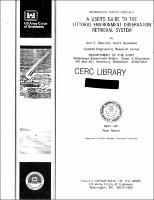Please use this identifier to cite or link to this item:
https://hdl.handle.net/11681/2814Full metadata record
| DC Field | Value | Language |
|---|---|---|
| dc.contributor.author | Sherlock, Ann R. | - |
| dc.contributor.author | Szuwalski, Andre | - |
| dc.date.accessioned | 2016-03-15T13:56:08Z | - |
| dc.date.available | 2016-03-15T13:56:08Z | - |
| dc.date.issued | 1987-04 | - |
| dc.identifier.uri | http://hdl.handle.net/11681/2814 | - |
| dc.description | Instruction report | - |
| dc.description | Abstract: The lack of available data on waves, currents, and sand movement along beaches in the United States is a major problem confronting planners and designers of coastal projects. Data from instruments such as wave and current gages are expensive to obtain and are rarely available at the precise location where needed. The Littoral Environment Observation (LEO) program was established to help overcome some of these problems. Under this program, volunteer observers are recruited to obtain daily visual observations of such coastal variables as breaker height, wave period, direction of wave approach, wind speed and direction, longshore current velocity, and beach slope. Observers obtain the data by using simple, inexpensive equipment and for some data, e.g.' wave height and direction, observers are asked to simply record a visual estimate. The LEO program has been ongoing since 1968, and observations have been made at over 200 sites along the coasts of the United States. The information collected has been placed in a computer data base and is available to the coastal community. This guide describes the LEO data collection process, the parameters involved, and the use of the LEO Retrieval System. The LEO Retrieval System is a computer-based analysis system that performs a variety of data retrieval, data analysis, and report processing ructions. | - |
| dc.publisher | Coastal Engineering Research Center (U.S.) | - |
| dc.publisher | Engineer Research and Development Center (U.S.) | - |
| dc.relation | http://acwc.sdp.sirsi.net/client/en_US/search/asset/1000854 | - |
| dc.relation.ispartofseries | Instruction report (U.S. Army Engineer Waterways Experiment Station) ; CERC-87-3. | - |
| dc.rights | Approved for public release; distribution is unlimited. | - |
| dc.source | This Digital Resource was created from scans of the Print Resource. | - |
| dc.subject | Beaches | - |
| dc.subject | Computer program--handbooks, manuals, data management | - |
| dc.subject | Currents | - |
| dc.subject | Littoral Environment Observation (LEO) Retrieval System | - |
| dc.subject | Monitoring | - |
| dc.subject | Sand movement | - |
| dc.subject | Waves | - |
| dc.title | A user's guide to the littoral environment observation retrieval system | - |
| dc.type | Report | en_US |
| Appears in Collections: | Instruction Report | |
Files in This Item:
| File | Description | Size | Format | |
|---|---|---|---|---|
| IR-CERC-87-3.pdf | 1.39 MB | Adobe PDF |  View/Open |